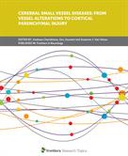Explore

Cerebral Small Vessel Diseases: From Vessel Alterations to Cortical Parenchymal Injury
0 Ungluers have
Faved this Work
Login to Fave
Cerebral Small Vessel Diseases (CSVD) represent a group of common age-related (but not clearly age-driven) microvascular brain pathologies, in which vessel injury leads to progressive accumulation of various small sized-tissue lesions (seen on neuroimaging or at autopsy). These lesions often accumulate without overt acute clinical symptoms and might eventually be responsible for progressive cognitive decline. More rarely, in advanced small vessel disease, these lesions occur in so-called eloquent brain areas (motor, sensory or visual pathways mostly) and will lead to ischemic or hemorrhagic strokes (CSVD is responsible for a quarter of all strokes), transient ischemic attacks, other transient focal neurological episodes, or acute convexity subarachnoid hemorrhage. Since small vessels, and hence the direct structural alterations of CSVD, cannot be easily visualized in vivo with the current clinical neuroimaging techniques, the brain parenchymal lesions which they are thought to cause and their corresponding Magnetic Resonance Imaging (MRI) markers have been widely adopted for evaluating CSVD. These markers have been a huge driver in the field. However, there are at least two major gaps in our knowledge on the nature of CSVD lesions: (1) exactly how intrinsic small vessel disease processes result in brain parenchymal injury (and are translated into MRI markers), and (2) how CSVD lesions contribute to neurological or cognitive symptoms. Also, although CSVD has historically mainly been described as a subcortical pathology, novel advancements in brain MRI over the last years have highlighted the importance of alterations within cortical areas of the brain and subsequently raised a new interest in CSVD. For example, there is now considerable evidence that innumerable small-sized lesions such as microinfarcts accumulate in the cortical mantle, which remains often missed by conventional MRI and systematic pathological evaluation. In line, the accumulations of lesions in distant brain areas eventually lead to morphologic and structural cortical alterations that are not easily detectable.
This book is included in DOAB.
Why read this book? Have your say.
You must be logged in to comment.
Rights Information
Are you the author or publisher of this work? If so, you can claim it as yours by registering as an Unglue.it rights holder.Downloads
This work has been downloaded 154 times via unglue.it ebook links.
- 56 - mobi (CC BY) at Unglue.it.
- 43 - epub (CC BY) at Unglue.it.
- 55 - pdf (CC BY) at Unglue.it.
Keywords
- Animal Models
- cerebral amyloid angiopathy
- Clinical & internal medicine
- medicine
- MRI
- Neurology & clinical neurophysiology
- Perivascular spaces
- small vessel disease
Links
DOI: 10.3389/978-2-88963-587-0Editions

